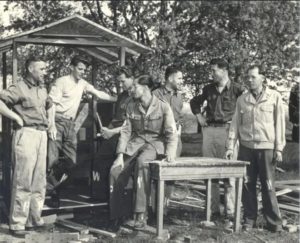Like, 425,000 of Them
I’ve been talking to book clubs and groups about “Something Like Treason,” which, of course, is about some pro-German U.S. soldiers during World War II. Until climate change became evident to enough people, World War II was surely our species’ most spectacular effort to destroy ourselves.
Why we’d do such things to ourselves remains unanswerable. Another question: why would we have 425,871 enemy soldiers living and working in the United States even as the war raged on.
We can answer that one: They were here because, as the tide of war changed in 1943, the Allies started capturing whole armies. Each victory was a welcomed step toward ending the carnage.
But each brought up a new question: what to do with them. There was no secure place to put them in Europe or Asia.
Enemies get to the U.S.
As luck would have it, there were empty ships heading back home. They had carried men and material to the fight overseas, and someone happily came up with the idea of stashing enemy combatants in their hollow bays on their way back.
Ultimately, they delivered 371,683 captured Germans, 50,273 Italians and 3,915 Japanese to the U.S.

And businesses, farmers, senators, and governors in 45 states competed to host the soldiers who were trying to kill us just a few weeks before. They were generally fit and about the same age as America’s missing (male) labor force off at war. Increasingly desperate for laborers, America would put them to work.
Thus the 425,000 foreigners ended up stockaded in 1,204 sites around the country. The prisoners would go to work each day, doing seasonal agriculture work, clearing land, spending their days in canning plants and kitchens, at dry cleaners and brick kilns.
Enlisted men got 10 cents a day for their troubles, plus 80 cents when they had a job to do. Officers got $20-$40 a month. Always willing to discriminate, we paid Japanese officers $5 less. Out of that treasure, they bought their own soap, candy, razor blades, tobacco and the like from the canteen like everyone else.
Making friends with the neighbors
They tried to escape often, although all escapees were captured or simply returned in a matter of days and sometimes hours. (The longest was close to three weeks.) For those who stayed, relationships with neighboring civilians were typically civil and even friendly.
Sometimes really friendly. In “Treason,” there’s an episode about several affairs between German prisoners and Army WACs stationed at the same camp. One WAC officer drily characterized the trysts as “an experiment in international relations.” In El Paso, local women wrote love notes to Italian prisoners, tossing them over the fencing.The city eventually passed an ordinance forbidding civilians to get within five feet of the stockade.
In Kansas, a friend remembers her mother telling the story of a cordial friendship with a POW working at a farm down the road. In South Carolina, the German POWs working the Camlin far grew close to the farm owners, were invited to Christmas dinner and sang carols with them around the piano.
One lesson: face to face, the enemy always looks just like us.